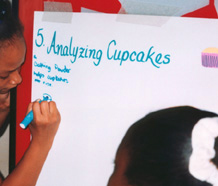Linking Food & the Environment (LiFE)
Professors Isobel Contento and Angela Calabrese Barton wanted to hook students with the wonders of science in a meaningful way. By developing an inquiry-based curriculum on what may well be a favorite topic for many kids--food--the pair are making science fun for children while also teaching them important lessons in nutrition and ecology. Funded by a Science Education Partnership Award from the National Institutes of Health, the LiFE curriculum helps students, particularly those living in urban poverty, acquire knowledge about how food is preserved, packaged, and processed and the resulting impact on the environment. Through such analysis, children develop critical thinking skills that help them identify the pros and cons of the food system so they can work towards developing socially and environmentally healthy communities.
Both Professor Contento and Professor Calabrese Barton had a strong desire to implement an inquiry-based science curriculum in upper-elementary and middle school grades to teach about food and the environment. The LiFE curriculum is based upon the QuESTA cycle which combines the scientific process and the learning cycle, providing students multiple opportunities to learn how to Question, Experiment, Search, Theorize and Apply what they learn. According to science education Professor Calabrese Barton, this means students actually do science. "In science education," she says, "we often hear about the importance of hands-on activities. We believe in that, too; however, we also believe that hands-on activities have to be followed with the hard work of building new and deeper understandings if we are to really be successful in helping all students become scientifically literate."
Dr. Contento, a professor in nutrition education, describes LiFE as enabling children to understand "the interaction between biology, personal choice, and the environment." The environment, she adds, makes it difficult to make healthy food choices, but LiFE helps students become competent navigators through the food system. Kids come away feeling empowered when they know what food choices are best for their bodies. "Being powerful," she says, "means selecting food that is helpful to the body and beating the system. They're showing independence and competence by selecting [healthy] foods so their bodies can do all they want their bodies to do."
Grant funding has supported LiFE thus far for two three-year periods for implementation in grades 4 through 6. During this time, teachers in five cities across the U.S. including New York, Philadelphia, St. Louis, Hayward, and Austin taught the curriculum, reaching more than 30 schools representative of over 6,000 students. In addition, the program's three modules--growing food, from farm to table and beyond, and food and health--are currently in the publication process. The program will now be federally funded for the next five years for implementation in middle schools. This will enable the TC professors to develop a fourth module of their curriculum, this time focusing on overweight prevention by helping students understand what the professors call C3--choice, control, and change.
One reason LiFE works well in classrooms is its simplicity. Schools lacking access to extensive laboratory equipment can still study food using the curriculum, making instruction appealing and non-intimidating for teachers. According to Professor Calabrese Barton, most teachers feel the curriculum starts with something they know about and something they feel will easily engage their students. Second, most students are excited that they learn how to become "food scientists." Drs. Contento and Calabrese Barton strive to excite parents, too, about LiFE by encouraging their involvement in a worshop series facilitated by TC students who are research assistants working on the project. Research assistants have gained additional experience through conducting initial needs assessment with teachers and students, researching their understandings about food and the environment, and developing, implementating, and assessing the curriculum. They have also presented on LiFE at national and international conferences as well as published in the Journal of Research in Science Teaching.
LiFE is reaching classrooms throughout the U.S., and enabling teachers and students to approach science in a fun, innovative manner. "Science, if inquiry-based, can be used to study any process," says Professor Contento. Luckily for students, it just so happens the professors are helping them to not only like the subject, but to also take away from it life-long lessons essential to leading healthy lives.
Read more at the LiFE Web site.
Published Wednesday, Mar. 23, 2005
